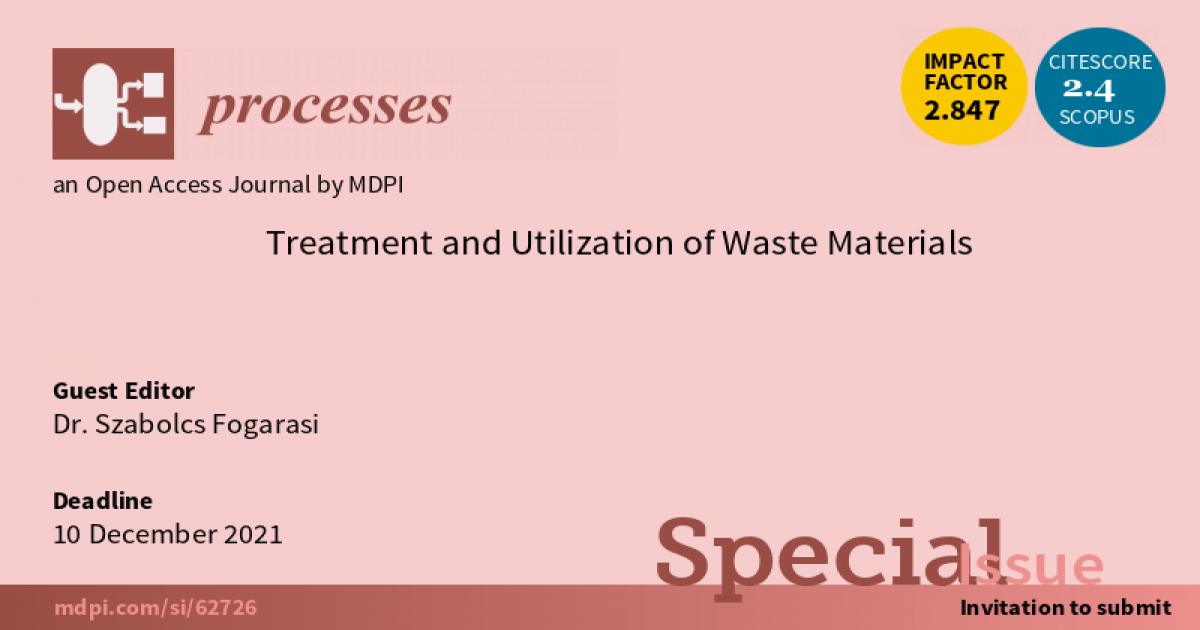Treatment and Utilization of Waste Materials
A special issue of Processes (ISSN 2227-9717). This special issue belongs to the section "Environmental and Green Processes".
Deadline for manuscript submissions: closed (10 December 2021) | Viewed by 9948

Special Issue Editor
Interests: waste treatment; industrial wastewater treatment; waste management; clean technologies; computer-aided process engineering
Special Issues, Collections and Topics in MDPI journals
Special Issue Information
Dear Colleagues,
The current trends of global population increase, industrialization, and technological development sustain and deepen one of the most important environmental and economic issues attributed to the accumulation and non-treatment of waste materials. The necessity to solve this ongoing global problem is emphasized by different policies, and requires further research activities in order to provide an adequate scientific framework for the large-scale deployment of innovative technological solutions. The development of eco-friendly waste-treatment technologies could accelerate the transition towards a sustainable industrial system in which undesired byproducts or waste materials can be efficiently recycled and transformed into useful resources for manufacturing processes. To promote the achievement of this goal, we invite the submission of innovative research works addressing critical areas of the Treatment and Utilization of Waste Materials. Subject areas include, but are not limited to:
- Sustainable production with low environmental impact;
- Industrial waste minimization;
- Improved resource efficiency and productivity, resource conservation and pollution reduction;
- Waste-to-resources, waste-to-energy;
- Manufacturing innovative products from adequately processed waste materials;
- Innovation in waste treatment (mechanical, biological, chemical, electrochemical, and thermal);
- Conceptual design, mathematical modeling, and simulation of waste-treatment technologies.
Dr. Szabolcs Fogarasi
Guest Editor
Manuscript Submission Information
Manuscripts should be submitted online at www.mdpi.com by registering and logging in to this website. Once you are registered, click here to go to the submission form. Manuscripts can be submitted until the deadline. All submissions that pass pre-check are peer-reviewed. Accepted papers will be published continuously in the journal (as soon as accepted) and will be listed together on the special issue website. Research articles, review articles as well as short communications are invited. For planned papers, a title and short abstract (about 100 words) can be sent to the Editorial Office for announcement on this website.
Submitted manuscripts should not have been published previously, nor be under consideration for publication elsewhere (except conference proceedings papers). All manuscripts are thoroughly refereed through a single-blind peer-review process. A guide for authors and other relevant information for submission of manuscripts is available on the Instructions for Authors page. Processes is an international peer-reviewed open access monthly journal published by MDPI.
Please visit the Instructions for Authors page before submitting a manuscript. The Article Processing Charge (APC) for publication in this open access journal is 2400 CHF (Swiss Francs). Submitted papers should be well formatted and use good English. Authors may use MDPI's English editing service prior to publication or during author revisions.
Keywords
- waste-to-resources
- waste-to-energy
- cleaner production
- waste treatment
- reduce pollution
Benefits of Publishing in a Special Issue
- Ease of navigation: Grouping papers by topic helps scholars navigate broad scope journals more efficiently.
- Greater discoverability: Special Issues support the reach and impact of scientific research. Articles in Special Issues are more discoverable and cited more frequently.
- Expansion of research network: Special Issues facilitate connections among authors, fostering scientific collaborations.
- External promotion: Articles in Special Issues are often promoted through the journal's social media, increasing their visibility.
- e-Book format: Special Issues with more than 10 articles can be published as dedicated e-books, ensuring wide and rapid dissemination.
Further information on MDPI's Special Issue polices can be found here.





